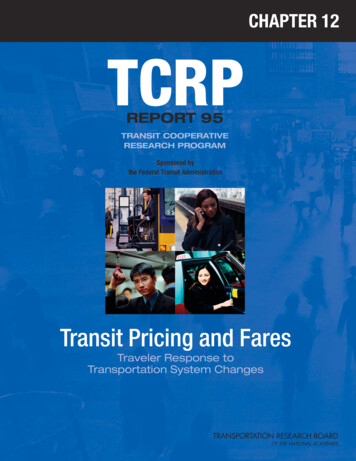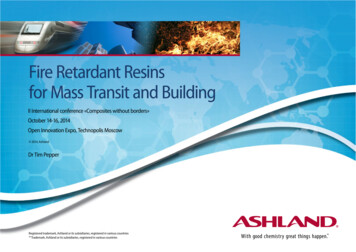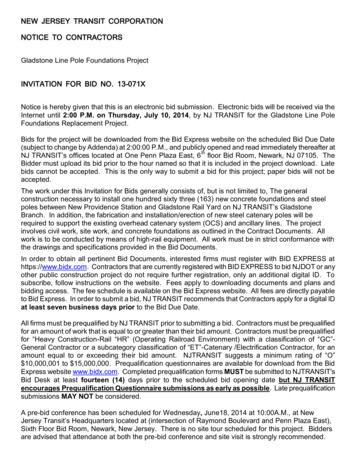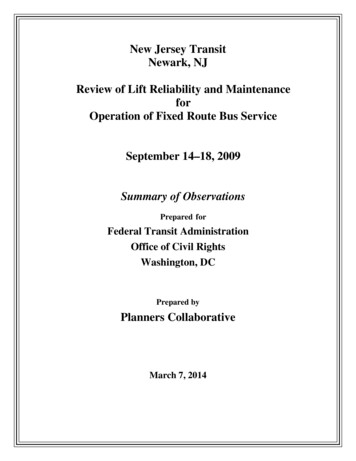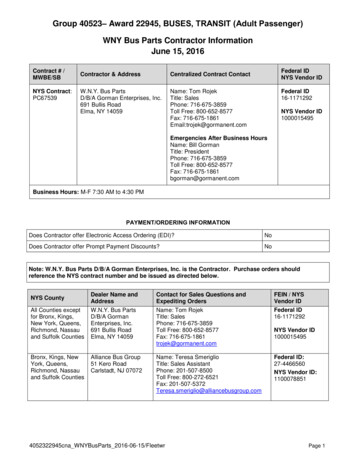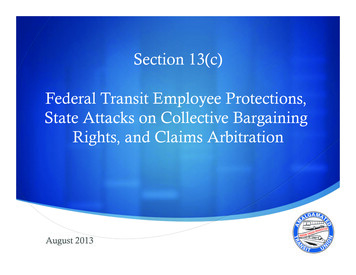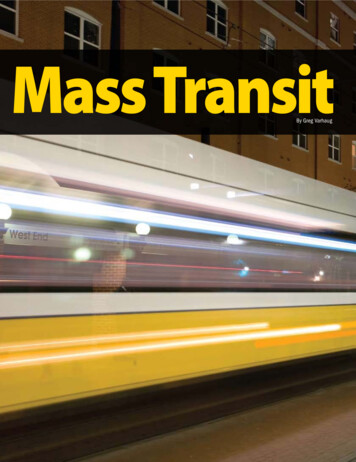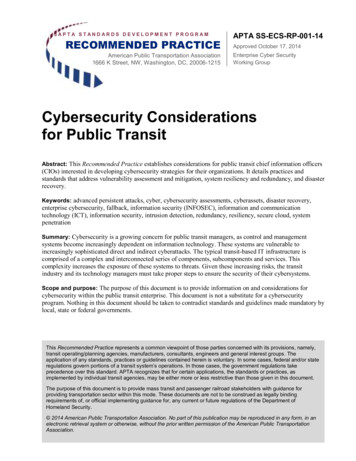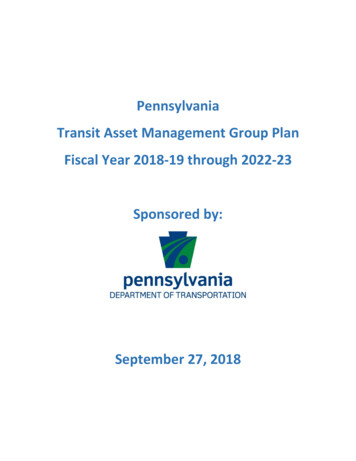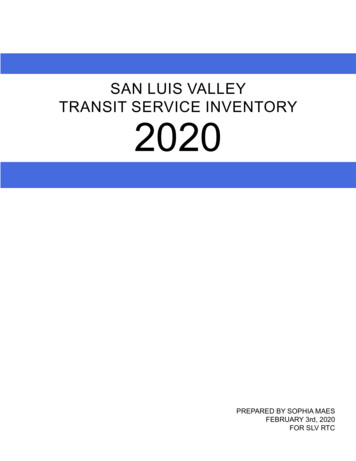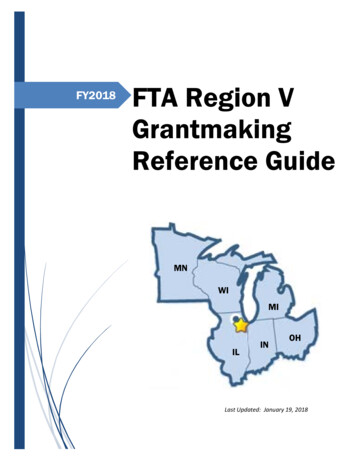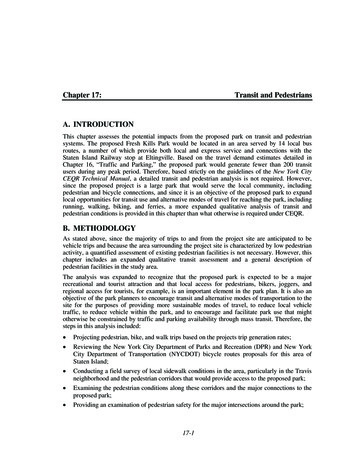
Transcription
Chapter 17:Transit and PedestriansA. INTRODUCTIONThis chapter assesses the potential impacts from the proposed park on transit and pedestriansystems. The proposed Fresh Kills Park would be located in an area served by 14 local busroutes, a number of which provide both local and express service and connections with theStaten Island Railway stop at Eltingville. Based on the travel demand estimates detailed inChapter 16, “Traffic and Parking,” the proposed park would generate fewer than 200 transitusers during any peak period. Therefore, based strictly on the guidelines of the New York CityCEQR Technical Manual, a detailed transit and pedestrian analysis is not required. However,since the proposed project is a large park that would serve the local community, includingpedestrian and bicycle connections, and since it is an objective of the proposed park to expandlocal opportunities for transit use and alternative modes of travel for reaching the park, includingrunning, walking, biking, and ferries, a more expanded qualitative analysis of transit andpedestrian conditions is provided in this chapter than what otherwise is required under CEQR.B. METHODOLOGYAs stated above, since the majority of trips to and from the project site are anticipated to bevehicle trips and because the area surrounding the project site is characterized by low pedestrianactivity, a quantified assessment of existing pedestrian facilities is not necessary. However, thischapter includes an expanded qualitative transit assessment and a general description ofpedestrian facilities in the study area.The analysis was expanded to recognize that the proposed park is expected to be a majorrecreational and tourist attraction and that local access for pedestrians, bikers, joggers, andregional access for tourists, for example, is an important element in the park plan. It is also anobjective of the park planners to encourage transit and alternative modes of transportation to thesite for the purposes of providing more sustainable modes of travel, to reduce local vehicletraffic, to reduce vehicle within the park, and to encourage and facilitate park use that mightotherwise be constrained by traffic and parking availability through mass transit. Therefore, thesteps in this analysis included: Projecting pedestrian, bike, and walk trips based on the projects trip generation rates;Reviewing the New York City Department of Parks and Recreation (DPR) and New YorkCity Department of Transportation (NYCDOT) bicycle routes proposals for this area ofStaten Island;Conducting a field survey of local sidewalk conditions in the area, particularly in the Travisneighborhood and the pedestrian corridors that would provide access to the proposed park;Examining the pedestrian conditions along these corridors and the major connections to theproposed park;Providing an examination of pedestrian safety for the major intersections around the park;17-1
Fresh Kills Park GEIS Meeting with Metropolitan Transit Authority (MTA)/New York City Transit (NYCT) toreview local bus routes and discuss opportunities for expanded transit for the proposed parkin the 2016 and 2036 analysis years; andReviewing proposed bus, borough rapid transit and mass transit linkages proposed for StatenIsland that could affect future mass transit demand.C. EXISTING CONDITIONSThe following description of existing transit and pedestrian networks is based on NYCTinformation and field surveys conducted during July 2007.TRANSITNumerous local and express bus routes and the Staten Island Railway provide transit service tothe area. Figure 17-1 shows the local and express bus routes serving the area around Fresh Kills,and Figure 17-2 shows the location of bus stops and transit stops located in the immediatevicinity of the project site. A description of each of the transit routes is provided below.RAIL SERVICEThe Staten Island Railway extends along the southern section of Staten Island and providesservice seven days a week between Tottenville on the west and St. George on the east, where itconnects with the Staten Island Ferry, which in turn provides service between Staten Island andlower Manhattan. The closest rail station to the proposed park is located in Eltingville, onRichmond Avenue near Amboy Road, approximately 1.5 miles from the project site. Local busroutes S59, S79, and S89 connect the project site with the Eltingville Station. Rail service to St.George operates on a 30-minute frequency during the weekday, Saturday and Sunday middayperiods, with more frequent service during the weekday AM and PM commuter peak periods.BUS SERVICEThere are 14 local bus routes that provide weekday service to the vicinity of the proposed park.Of these, seven routes operate on Saturdays and Sundays as well as weekdays. As shown inFigures 17-1 and 17-2, one or more of these local routes have stops within a short walk ofentrances to the proposed park. Routes S59 and S79 provide service during all times between theproposed park and the Staten Island Railway station at Eltingville. Route S89 provides limitedstop service during the weekday AM and PM periods between the proposed park and the StatenIsland Railway station at Eltingville. The area is also well served by express bus routes whichprovide service to Downtown and Midtown Manhattan. Table 17-1 provides a summary of theNYCT local and express bus routes and their frequencies of operation during the weekday andweekend peak hours. As shown in the table, although express service is provided to the area it isprimarily a service that is provided during the weekday (only the X1 provides weekend service).PEDESTRIANSPedestrian traffic in the area is light (field observations, July 2007). Most, but not all, of thestreets in the area have sidewalks on one or both sides of the street, and crosswalks atintersections. In terms of traffic control, all the intersections on Richmond Avenue (along theeastern boundary of the project site) are signalized and provide crosswalks. Along the southernboundary of the project site, the intersections of Arthur Kill Road at Annandale Road, WoodrowRoad, and Arden Avenue are signalized and provide crosswalks. Figure 17-3 shows the builtsidewalk network on streets bordering the park (survey conducted in July 2007). Victory17-2
Chapter 17: Transit and PedestriansBoulevard, Wild Avenue, the east side of Richmond Avenue and the south side of Arthur KillRoad have sidewalks on all or most of their rights-of-way. There are no sidewalks bordering theproposed park on the west side of Richmond Avenue between the northern entrance to the StatenIsland Mall and Forest Hill Road, and only two small sections of sidewalk on the north side ofArthur Kill Road. In addition, there are no sidewalks on either side of Travis Avenue passingthrough the William T. Davis Wildlife Refuge, immediately north of the park. Sidewalksbordering the park are in various states of physical condition, generally narrow, and sometimesovergrown with vegetation.Table 17-1Existing NYCT Local Bus Routes Serving the Study AreaBusRouteS44S54S55S56Start PointNew SpringvilleWest New BrightonHuguenotHuguenotEnd PointSt. George Ferry TerminalEltingvilleStaten Island MallStaten Island MallS59Hylan dS94LtdX1X4X5X6X7New SpringvilleVictory Blvd./Wild AvenueRichmond Terrace/Park AvenueSt. George Ferry TerminalSt. George Ferry TerminalTottenvilleRoutingvia Richmond Avenuevia Manor Road/Arthur Kill Roadvia Annandale/Richmond Avenuevia Richmond Avenue/Arthur Kill & ForestRoadsvia Richmond AvenueFreq. of Bus Service (Headway in Minutes)MiddayMiddayAMMidday PM Saturday Sunday91515151513303030301540401240401520152015via Victory Boulevard/Bradley Avenuevia Victory Boulevard15102015181515201530St. George Ferry Terminalvia Arthur Kill/Ricnmond Roads1620151520Bay Ridge, BrooklynSt. George Ferry TerminalStaten Island MallTottenvillevia Hylan Boulevard/ Richmond Avenuevia Richmond/Arthur Kill Roads10-13-102012-12-Hylan Boulevard/Richmond AvenueNew SpringvilleBayonne, NJvia Richmond Avenue30-15--St. George Ferry Terminalvia Victory Boulevard/Travis Avenue10-15--TravisSt. George Ferry Terminalvia Victory Boulevard15-15--New SpringvilleSt. George Ferry Terminalvia Richmond eManhattan8-12--X11X15X17X19X22X23Port RichmondEltingvilleHuguenot or AnnadaleHuguenot or AnnadaleTottenvilleHuguenot Avenue/Drumgoole RoadHylan Boulevard/Tysens LaneEltingville Transit CenterManhattanLower ManhattanManhattanManhattanMidtown ManhattanMidtown Manhattan9108151011-11108111115--Midtown Manhattanvia Hylan Boulevard/Richmond Avenuevia Richmond Avenue/Victory Boulevardvia Richmond Avenue/Victory Boulevardvia Richmond Avenue/Victory Boulevardvia Giffords Lane/Nelson Avenue/Hylan Boulevardvia Giffords Lane/Nelson Avenue/Hylan Boulevardvia Victory Boulevard/Gannon Avenuevia Richmond Road/Arthur Kill Roadvia Richmond/Huguenot/Arden Avenuesvia Huguenot/Arden Avenuesvia Bloomingdale/Amboy Roadsvia Seguine Ave/Foster Road/Woodrow Roadvia Huguenot/Arden Avenues10-15--Midtown Manhattanvia Travis Avenue9-12--X24X31Source:New York City Transit, Staten Island Bus Map (2007).Figures 17-4, 17-5a, and 17-5b provide photographs of existing pedestrian corridors around theproject site—including sidewalks, crosswalks and corners—at major intersections bordering theproject site on Richmond Avenue, Arthur Kill Road and Victory Boulevard/Wild Avenue.17-3
Fresh Kills Park GEISBIKEWAYSIn the vicinity of the project site, a proposed DPR/NYCDOT Bikeway runs along Forest HillRoad (the northwestern boundary of Latourette Park) as shown in Figure 17-6. Within the studyarea, the bikeway runs along the entire segment of Forest Hill Road between Richmond Avenueand Travis Boulevard.However, these bikeways are largely planned and do not currently exist (see Figure 17-6).Proposed improvements to provide bikeway connections is provided below, under “The FutureWithout the Proposed Project.”D. T H E F UT UR E W I T H OUT T H E PR OPOSE D PR OJ E C T : 2016 AND 2036OVERVIEWIn the future without the proposed project, transit demand in the area is expected to increase dueto background growth. The background growth used in forecasting the 2016 and 2036 pedestrianand transit conditions were developed in consultation with the NYCT. Based on NYCT’srecommendation a background growth rate of 1.5 percent per year—as identified in the CEQRTechnical Manual for the borough of Staten Island—was used in the qualitative assessment offuture 2016 and 2036 pedestrian and transit conditions in the study area.Various development projects planned for the study area by 2016 could also result in increasedpedestrian and transit activities in the broader study area as well as improved sidewalkconditions around project sites. Because the 2017 to 2036 time frame is one to three decades inthe future, there are no known development projects in the study area for this time period.Therefore, the pedestrian and transit levels beyond 2016 were assumed to increase due only tothe background growth and no individual development projects were assumed in the qualitativeassessment of pedestrian and transit conditions in the 2017 to 2036 period study area. Therewould also be the park access and improvements provided as part of the Owl Hollow project inthe 2016 No Build condition within South Park.In addition, there are a number of street improvement studies and projects proposed for the area,including those proposed by both the New York State Department of Transportation (NYSDOT)and NYCDOT, such as improvements to the West Shore Expressway and Korean War VeteransMemorial Parkway, and improvements to Arthur Kill Road, for example. The West ShoreExpressway and Korean War Veterans Memorial Parkway projects are not expected to affect thetransit and pedestrian conditions in the study area. However, the improvements to Arthur KillRoad—which could include the construction of new sidewalks as well as crosswalks at majorintersections and the project site’s southerly boundary—are expected to improve pedestriancirculation and safety in the general study area.NO BUILD TRANSIT CONDITIONS: 2016 AND 2036POTENTIAL FUTURE TRANSIT IMPROVEMENT PROJECTSIn addition to the roadway improvement projects discussed above, there are a number of transitrelated projects under consideration for Staten Island, including the following:West Shore Light Rail. In 2004, the Staten Island Economic Development Corporationcompleted a study to examine the feasibility of constructing a West Shore Light Rail system that17-4
Chapter 17: Transit and Pedestrianswould begin at the south shore of Staten Island, and extend north along the West ShoreExpressway corridor, utilizing the existing rail right-of-way in Staten Island’s northwesterncorner, and, crossing the Bayonne Bridge to link with the Hudson-Bergen Light Rail line inBayonne, New Jersey. The study determined that by the year 2020, the light rail could expect totransport approximately 31,000 riders per day. The second phase of this study includes anexamination of the proposed light rail alignment, potential light rail vehicles, ridership, capitaland operating costs, and engineering issues that would need to be addressed to implement theproject. The project is currently in its second study phase.North Shore Light Rail. This approximately 5-mile-long light rail route would connectArlington and St. George Ferry Terminal potentially cutting commuter along the corridor time inhalf. It is assumed that construction could be completed within 8-10 years depending on federalfunding. A feasibility study for this project is currently awaiting funding approval.Extension of S74 Bus Route. A NYCT study is currently underway to study local bus routes todetermine if the S74 Bus Route could be extended to include a loop around Charleston’
Route S89 provides limited-stop service during the weekday AM and PM periods between the proposed park and the Staten Island Railway station at Eltingville. The area is also well served by express bus routes which provide service to Downtown and Midtown Manhattan. Table 171 provides a summary of the - NYCT local and express bus routes and their frequencies of operation during the weekday and .
